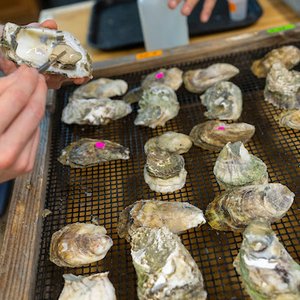Abstract
Rotifers are used as the first feeding diet for the larvae of many commercially produced marine fish species. However, the nutritional requirements of marine fish larvae appear to be better fulfilled by their wild feed, copepods. Consequently, rotifers are fed diets that alter their body composition to better imitate copepod composition and this results in greater success when rearing rotifer fed marine fish larvae. Despite this, copepod fed fish larvae still have higher growth rates and survival than rotifer fed larvae. This may occur because of the less investigated mineral differences that exist between rotifers and copepods. The concentration of selenium (Se) in rotifers Brachionus sp. (0.08–0.09 mg Se kg−1 dry weight) can be over 30 fold lower than the concentration found in copepods (3–5 mg Se kg−1 dry weight). In this study, the enrichment and retention of Se in rotifers fed Se enriched yeast (Se-yeast) were investigated. Rotifer Se concentration increased linearly with increasing levels of Se-yeast, with rotifers reaching a maximum of 138 mg Se kg−1 dry weight. The use of Se-yeast was highly effective, with only 1% of the batch culture or short term enrichment diet needed to be replaced with Se-yeast to achieve copepod Se levels. At this feeding level there were no negative effects on rotifer egg ratio or population growth. Uptake of Se from Se-yeast was over 40 fold higher than obtained from using sodium selenite in short term enrichments (3 h). Se-yeast enriched rotifers had a high retention (100–85%) of Se for up to 10 h storage in clear water at cold (10 °C) or warm (20 °C) temperatures, while storage in green water (with algae) resulted in a slightly lower Se retention (65%) in a similar time period (8 h). Overall, rotifers enrichment with Se-yeast resulted in reproducible concentrations of Se that were then retained for extended periods of time. This will allow Se-yeast enriched rotifers to be used as a Se delivery method for fish larvae nutritional requirement or toxicological studies.
Keywords
Rotifers, Selenium, Enrichment, Minerals, Copepods, Marine fish larvae
Authors
S. Penglase a, K. Hamre a, J.W. Sweetman b, A. Nordgreen a,1
a National Institute of Nutrition and Seafood Research (NIFES), PO Box 2029, NO-5817 Bergen, Norway
b Alltech Bioscience Centre, Sarney, Summerhill Rd, Dunboyne, County Meath, Ireland
Publisher
Elsevier. Aquaculture 315 (2011) 144–153
[Source Nofima. For more information please contact Reidun Lilleholt]
a-new-method-to-increase-and-maintain-the-concentration-of-selenium-in-rotifers-brachionus-spp







